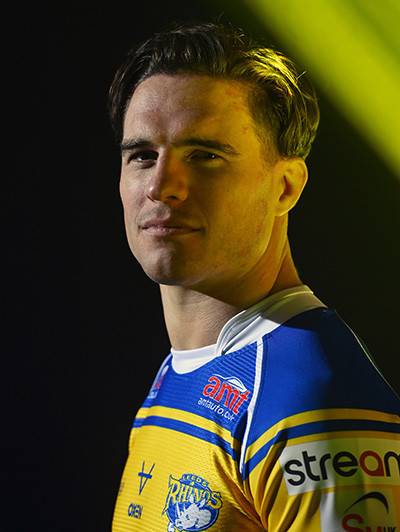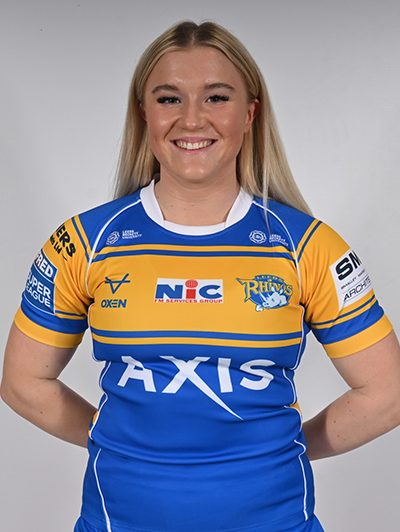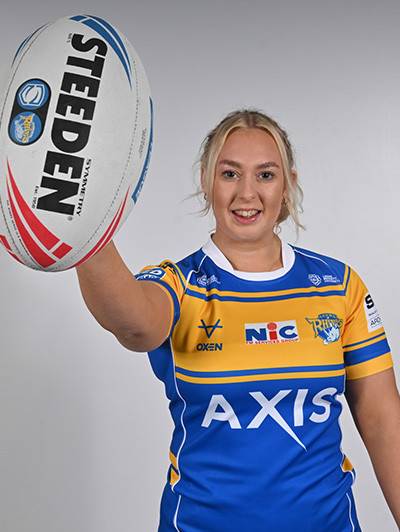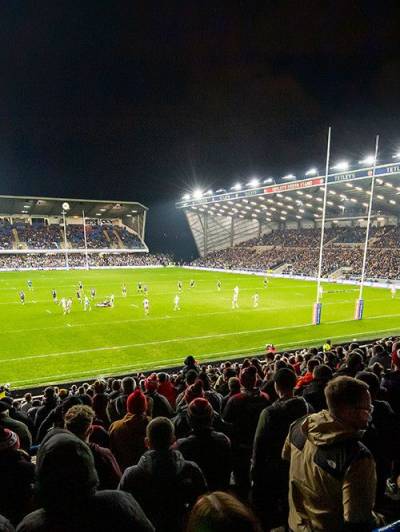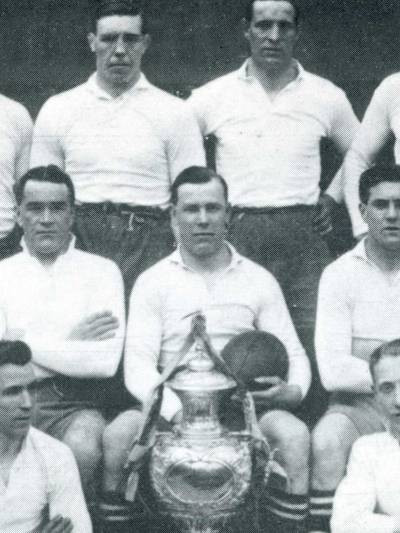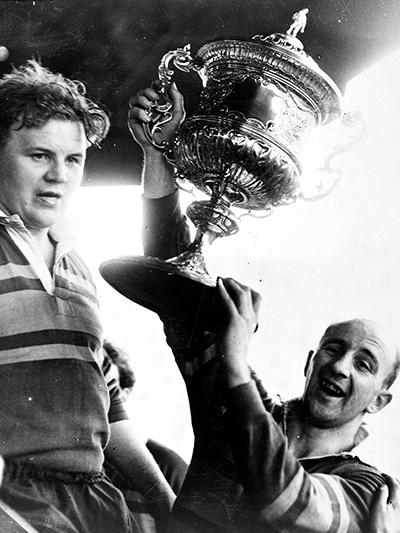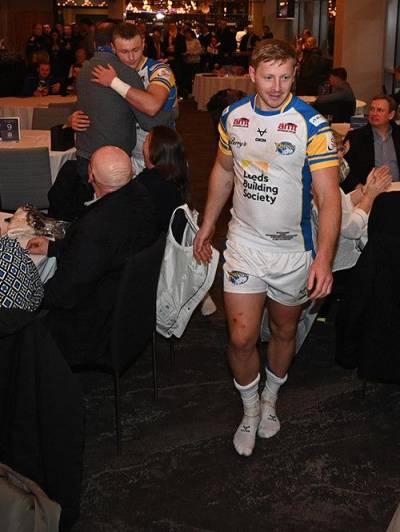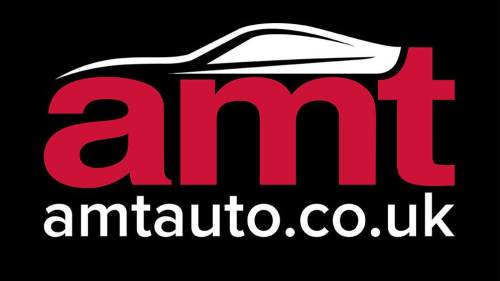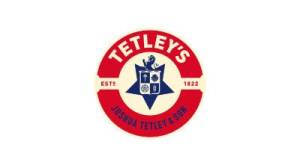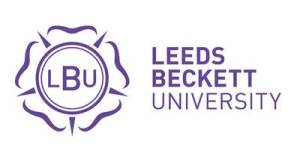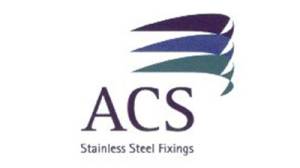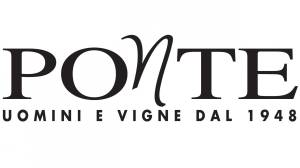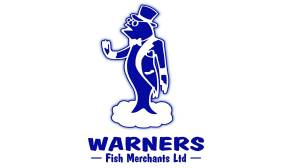1931-1932
The season opened in splendid fashion, gradually merged into a period of mediocrity and uncertainty, and finished in a blaze of glory with the winning of the R. L. Challenge Cup.
Although the previous campaign had been quite successful the management paid particular attention during the close season to possible scrummaging weaknesses so that by the end of September no less than four new front row forwards had been signed: D.R. James, the Welsh R.U. International from Treorchy; C. Mann, the Yorkshire hooker from Halifax R.U.F.C.; J. Powell, from Castleford; and John Lowe, the ex-Wigan Highfield captain and one of the best hookers in the game. In addition negotiations had been completed for obtaining the services of Kingston, the Australian International loose forward, but a last minute hitch prevented him joining the club. The Welsh International R.U. wing forward, I. Jones, was signed later in the season, and had an impressive debut at Bramley.
Departures during the early months of the season included Walter Swift, to Batley; George Andrews, to Castleford; Harry Jones, to Halifax; Billy Watson, to Keighley, where he is still a member of the training staff, and ?Ginger? Thomas to York.
The campaign opened in record style: nine successive victories (eight in the League and one in the Yorkshire Cup Competition) was the ?best ever? start to a season for a Leeds team. Thirty years earlier, in 1902-03, there had been an opening sequence of eight victories. Thus, for a long spell we headed the League Table, but valuable ground was lost in January when we met with defeat at the hands of York, Swinton and Hull. Easter, too, brought disaster: on Good Friday, the match with Halifax at Headingley had to be abandoned after ten minutes play when fire broke out and completely gutted the North Stand; the remaining holiday fixtures brought defeats at Hull, and Dewsbury; whilst the following Saturday a very strange looking Headingley was the venue for our fourth successive defeat, this time by Oldham. Our chances of appearing in the First Four play-off now appeared extremely remote, but the five consecutive victories with which we wound up our League programme took us into third place, our final fate depending upon the last match, at Wigan, where we gained a convincing victory by sixteen points to seven. Our fifth successive appearance in the League Championship Semi-Final took us to St. Helens, but Leeds were compelled to field a weakened side as Stan Smith, Joe Thompson, Les Adams and John Lowe had already left these shores with the Australian Touring party. However, our depleted team put up a good show and only went down by 9 points to nil, having only one try scored against them. Thompson?s goal-kicking was sadly missed, and might well have had an important bearing on the game.
Our interest in the Yorkshire Cup faded unexpectedly when York, with many ex-Leeds players, put paid to our hopes with a fully merited win at Headingley by 14 points to 9 in the 2nd Round.
But 1932 will always be remembered at Headingley because of our triumph in the R. L. Cup Competition. The luck of the draw took us to Hull in the 1st Round, where a late try by Jeff Moores, brilliantly converted by Joe Thompson, pulled us through by 5 points to 2. Easy victories over Keighley and Leigh took us to the Semi-Final stage, and now the battle for the trophy was really on. A crowd of almost 32,000 saw a stirring struggle with Halifax at Fartown, where the game finished with honours even at 2 points each. The replay was at Belle Vue, Wakefield, four days later, and Leeds gained a merited win by 9 points to 2. The chief factor in our success was the splendid half-back partnership of Evan Williams and ?Juicy? Adams. Adams had not been available for the previous game owing to influenza. So Leeds were in the Cup Final once again, after a lapse of nine years, and many associated with the game had only one regret ? that the Final was not to be staged at Wembley. The story of the Cup Final Match is given in the following Press Report.
RUGBY LEAGUE CHALLENGE CUP FINAL, 1932
Wigan, Saturday
The thirteenth minute of the second half of this Yorkshire and Lancashire final for the Rugby League Challenge Cup this afternoon was the decisive one, for in it Harris, the tall Australian wing threequarter, got the try which, in the end, gave Leeds their victory, the final score being 4 goals. 1 try (11 points) to 4 goals (8 points).
And so Leeds join the select circle of clubs which have won the trophy thrice. Batley, Huddersfield, Halifax, Oldham and Swinton are the other members, but only the ?Gallant Youths? and the Fartown men share with Leeds the distinction of having played in three finals without defeat. Oldham have taken part in seven, Swinton in five, and Halifax in four.
Leeds, if only because of Harris?s try, deserved the Cup. It was a grand effort, in which opportunism, skill, and a commanding speed were combined; a real Cup winning try in fact. But there was much more in the Headingley men?s victory than this try. In the first half when they had the wind, Leeds worked to a definite plan of campaign which paid, and in the second half-when they had to meet the full force of a grim and prolonged Swinton attack they stood firm in defence and always had the last word.
Convincing Leeds Defence
The Leeds defence in the opening five minutes of the second half and the last ten minutes of the game was as convincing as anything they have shown in this Cup campaign, in which, be it noted, they have not had their line crossed. As a matter of fact, the only try scored against either side in this competition was that gained so brilliantly by Harris, and this plain statement in itself is surely proof enough of the merit of the Leeds victory.
Swinton folk may say that the scrummage half back failings of Bryn Evans, who could not put the ball into the pack to the satisfaction of the referee, Mr. F. Peel, of Bradford, cost them the Cup; but they must not overlook the four penalty goals kicked by Hodgson in reply to those kicked by Thompson.
Harris? try won the match. It came at just the right point in the game to hearten the Leeds men. They had turned round with a useful lead of 8 points to 2, and they had had that lead reduced by two points when, in the fourth minute of the second half, Hodgson kicked his second goal.
Then they had to stand the battering of a Swinton attack, which increased in fierceness and sureness as the Lancastrians? pack began to work up enthusiasm for what everyone thought was going to be the drive to victory. It was at this time that Leeds secured respite with a penalty kick, and it was from a scrummage near the halfway line, that the Swinton backs got the ball.
Bryn Evans had it out to Rees in a shot, and the stand-off half sought with his pass to find Green the young centre who took the place of Whittaker. But Green could not get to the ball. Moores swooped on to it, and passed to O?Rourke, who had taken up the correct supporting position, and O?Rourke let the ball go with the necessary rapidity and accuracy to Harris.
It was the only move likely to beat the quick covering of the Swinton defence. The left wing was partly opened. Harris went straight along the touch line to slip past Kenny, and then, with something like half the length of the field to go, he had only to beat Scott, the full back. But he had to stay on the touch line, for had he attempted the cut inside he would have met the rallying defenders.
Harris?s Change of Speed
Scott, like Davies, the Halifax full back, who had a similar sort of attack to meet in the semi-final replay at Wakefield, must have felt sure of getting his man, for the Leeds winger was moving within inches of the touch line, But, again like Davies, Scott made no allowance for Harris?s change in speed. Just when the tackle was to be made, the Australian accelerated, and left Scott groping in futile fashion while he dived in at the corner.
The try counted for three points-the three points that divided the scores when the final whistle sounded-but really it meant much more than that. It knocked Swinton out of their attacking stride for ten important minutes, and when they were again driven to the wall Leeds had the strength to fight all the harder.
Swinton never spared themselves, and the closing stages were as thrilling as anything seen in a Rugby League Cup Final, but Leeds never faltered. Adams held Evans, Williams held Rees, Moores and O?Rourke gave Green and Harold Evans no rope, and Glossop, who rose to the occasion in grand style-a style reminiscent of the time when he was loose forward to Jonathan Parkin in the Wakefield Trinity team-held Butters. When the last Swinton attack had been beaten back, Leeds indulged in a round of passing-their gesture of victory-which took the ball to the Swinton half, where it was when the 80 grim and testing minutes ended.
Attacks Mastered
It will be said, of course, that the match never produced the open football of which the sides are known to be capable. But what could be expected? The sides had gone through the four rounds of the competition without having their lines crossed: defence was bound to be the master of attack. And that, of course, is just what happened, though it is true that Leeds neglected at least one try-scoring chance in the first half, and that after Harris had got his try they lost another. It is true also that in the early moments of the last crashing Swinton attack Billo Rees for once found himself clear of the arms of Williams. He had whipped round Bryn Evans to take a reverse pass, and he was so keen on cutting out the opening for a pass back to Green that he ignored the avenue to the line there for him.
Adams had a good game for Leeds. He was generally in the right place at the right time, and at the scrummage he gave little away, though, because of the scrummaging superiority of the Swinton forwards, he was generally seeking the ball. At any rate, he and his partner, Williams, along with Glossop, the loose forward, were more than good enough for Bryn Evans, Rees and Butters; and these three Swinton men, with as much of the ball as they wanted in the second half, tried every move on the board.
Evans exploited his craft to the full, but always he was checked. He tried to run, he tried to link up his backs, he tried the interchange of positions with Butters and Rees, and he tried to get the quick winging forwards of Hodgson and Beswick away. He got near success only to see the Leeds defence stiffen successfully, sometimes in the last yard. He never made up for the penalty goals he conceded in the first half simply because he was not allowed to do so.
There came the time when he realised that his men, with all their short passing and quick backing up, had not the speed to get through, and then he gave the game into the hands of his forwards. But they were met at their own game by the Leeds pack, and the proof of this is that Hodgson, so often an outstanding figure, was only occasionally dangerous.
A Hardworking Pack
Thompson, the only man in the Leeds ranks who was in the cup winning side of 1923, led his pack in the right way, and everyone of the other five supported him untiringly. Douglas and Cox were grafters all the time, R. Smith, who was preferred to Satterthwaite in the front row, was just as useful and Lowe, the ?hooker,? was as good as any of the others when the line had to be held. Why, once in the second half Hodgson got the ball on the run and went with all his power to batter down the defence. He was seized on the line by Thompson and Lowe and carried shoulder high for five or six yards. Another time Butters, on whom Evans called in the last effort of all (one recalls Parkin using Butters in much the same way in a Test match at Headingley), tried to fight round the blind side of the scrummage to the corner flag. He also got to the line only to be torn back by Glossop.
The Leeds forwards had their share in this victory, just as they had in the semi-final triumph at Wakefield, and that though they were pushed about in the second half scrimmaging. On Stanley Smith?s wing, Goulthorpe, without being called upon for anything especial in attack, never slipped in defence, and Brough, who kicked such a fine length with the wind in the first half, was a sure and resolute defender in the second. There were times when he had to go down to the Swinton forwards? feet. He never hesitated, and he was the man who held Harold Evans and Butters when they were very near tries at the post.
Comparatively, Scott had an easy time. He never had to face the attack against which Brough stood in the second half. There was all the craft and experience of a dozen league and Cup Finals in Swinton?s second half work, but it was unavailing.
How the Scoring Went
In the first half, when they had the wind, Leeds, of course had the main part of the attack, and their kicking, guided by Brough, Moores and Adams, kept Swinton worried. Thompson kicked his first goal at the end of eight minutes, and the three others came in the next eleven minutes. Leeds? likeliest raids in this half were seen when Harris and the backs were following up the high balls which troubled the Swinton defenders so. Hodgson?s goal, from a penalty for offside at the serum against Adams, came eleven minutes before half time.
Swinton were encouraged with another penalty goal early in the second half, and they were playing on lines which promised to take them to victory until Harris got his try. Then, with two more penalty goals by Hodgson, they reduced the Leeds lead from seven points to three and there their mighty and gallant attack was held.
It was a grand finish to a fast and gruelling game in which the unsatisfactory feature was the necessity for penalties at the scrummage. Mr. Peel, however, took the right stand from the start. He refereed a good game. Still, it is not pleasant to think that 16 of the 19 points came from penalty kicks, excellent though the skill of Hodgson and Thompson was in the conversion of the penalties into goals.
Another unsatisfactory feature was the attendance. There were no more than 29,000 spectators-the receipts were ?2,450-at this the first final in the North since 1928. Wigan in these hard times is not the best centre for the final, that is clear. The distance from Yorkshire is considerable. This dearly is a point for the Rugby league to consider in future, and it is suggested that they might also debate whether a minimum admission charge of Is. 6d. and the broadcasting of the game did not also affect the attendance. Quite 11,000 more spectators were expected. The day was a good one.
Teams-Leeds -Brough; Harris, Moores, O?Rourke, Goulthorpe; Williams, Adams; Lowe, Thompson, R. Smith, Cox, Douglas, Glossop.
SWINTON-Scott; Buckingham, Green, Evans (H), Kenny; Evans (B), Rees; Armitt, Strong, Wright, Hodgson, Beswick, Butters. Referee-Mr. F. Peel (Bradford)
